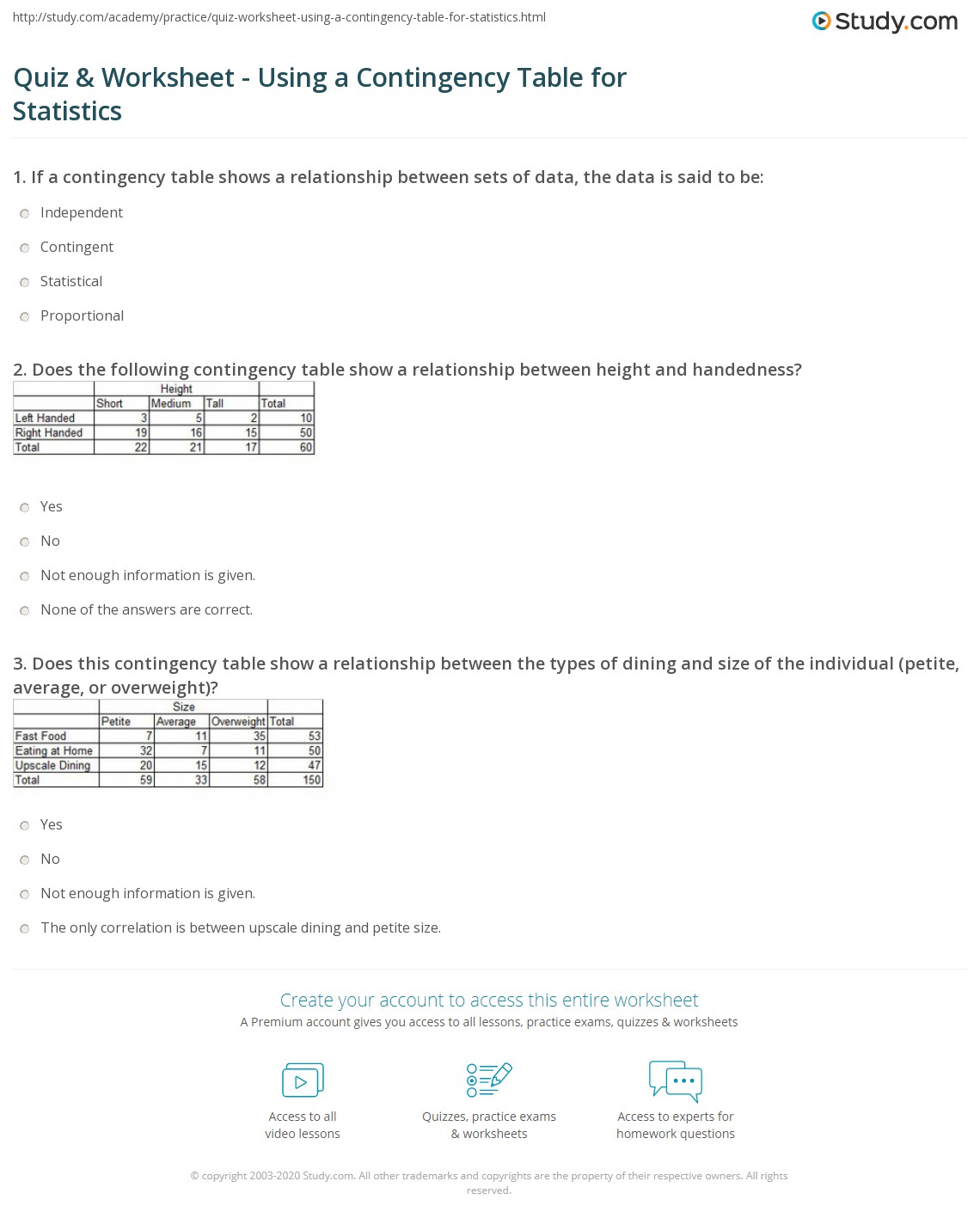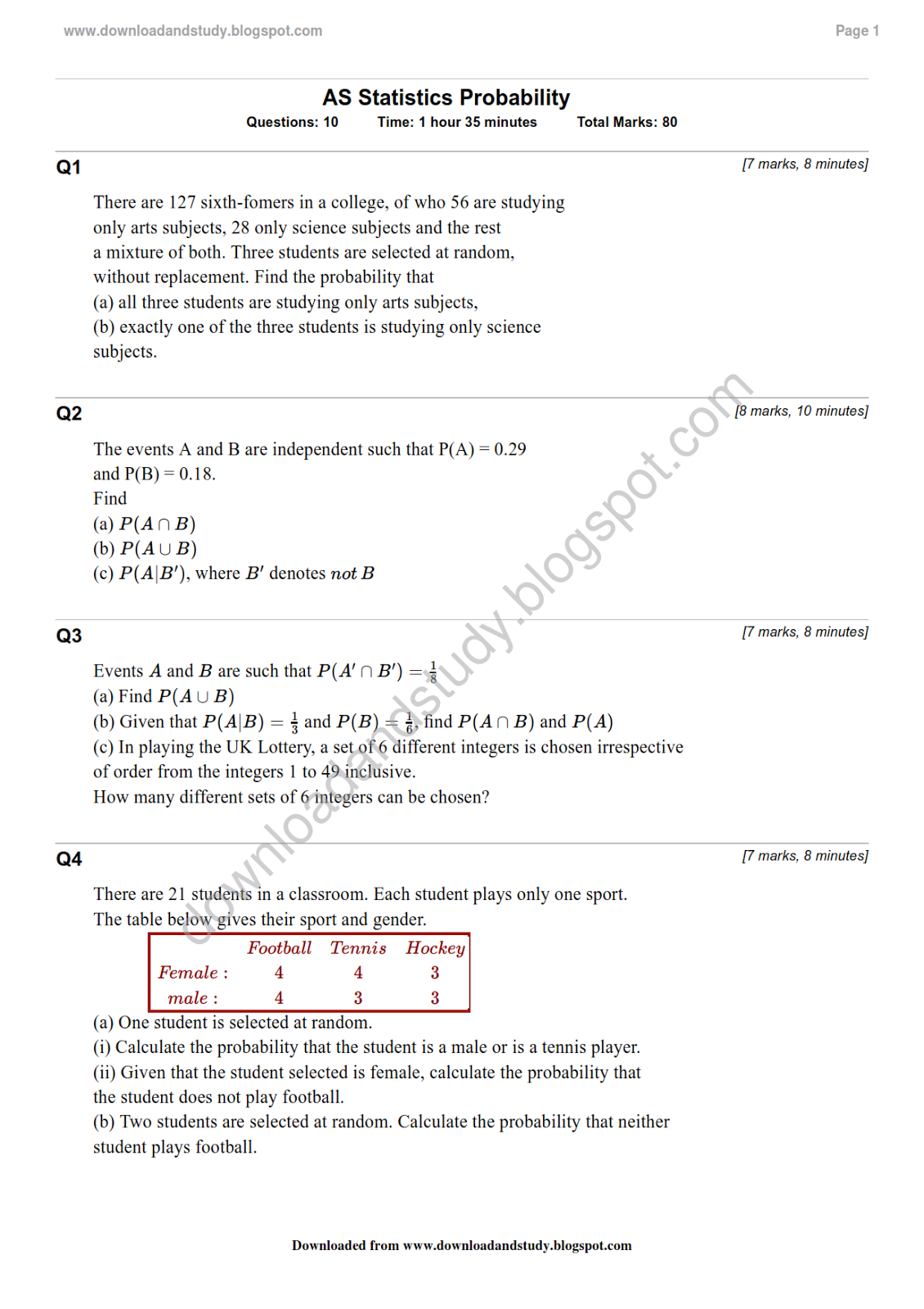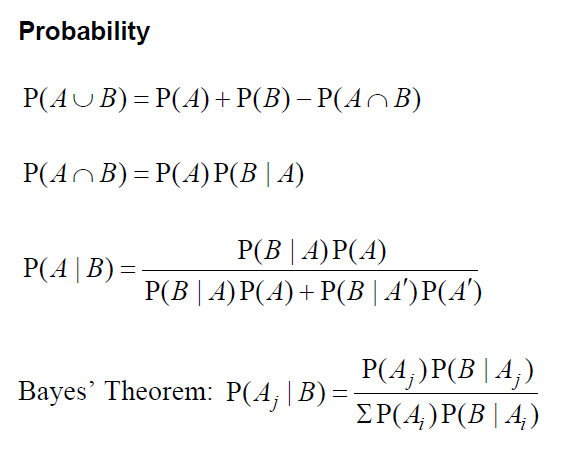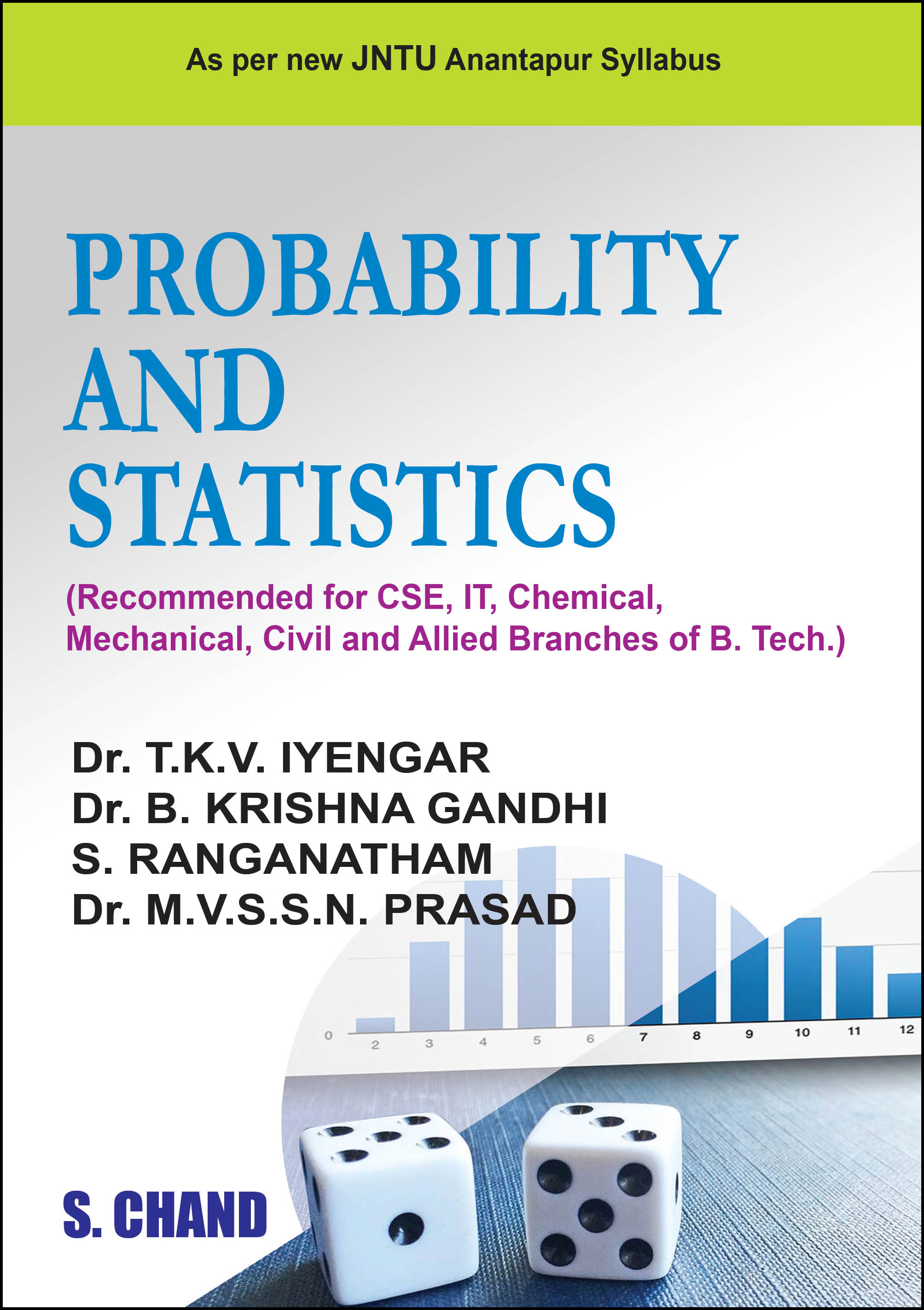Probability and statistics for
Data: 3.03.2018 / Rating: 4.6 / Views: 679Gallery of Video:
Gallery of Images:
Probability and statistics for
An Introduction to Basic Statistics and Probability Shenek Heyward NCSU An Introduction to Basic Statistics and Probability p. 140 The probability of any sample point can range from 0 to 1. The sum of probabilities of all sample points in a sample space is equal to 1. The following sample problems show how to apply these rules to find (1) the probability of a sample point and (2) the probability of an event. Class site for Probability and Statistics at Olin College, Fall 2011 : probability statistics adverse effects collected data, bits pilani introduction probability statistics solution, write probability statistics hiring people, free help with statistics problems, statistics chat room, probability and statistics tutor, need help with statistics course, statistics help. Learn high school statistics for freescatterplots, twoway tables, normal distributions, binomial probability, and more. Full curriculum of exercises and videos. ix PREFACE This book is both a tutorial and a textbook. This book presents an introduction to probability and mathematical statistics and it is intended for students I introduce the basic concepts and calculations of Probability. For more free math videos, visit: In this video, I cover: Sample Space, Sample points and. probability and statistics by engr. bautista In the Probability and Statistics course the unit is a classical treatment of probability and includes basic probability principles, conditional probability, discrete random variables (including the Binomial distribution) and continuous random variables (with emphasis on the normal distribution). Joe Blitzstein, Professor of the Practice in Statistics Harvard University, Department of Statistics Contact. About; Book; Handouts; Practice and Solutions; Stat 110 on YouTube; Stat110x on edX. It is concerned with the probability distributions of certain statistics that arises from a sample, where a statistic is a random variable whose value is determined by the sample data. Two important statistics are the sample mean and the sample variance. A Tutorial on Probability Theory Paola Sebastiani Department of Mathematics and Statistics University of Massachusetts at Amherst Corresponding Author: Paola Sebastiani. Department of Mathematics and Statistics, University Probability and Statistics or also called Statistics and Probability are two related but separate academic disciplines. Statistical analysis often uses probability distributions, and. (Statistics) statistics a measure or estimate of the degree of confidence one may have in the occurrence of an event, measured on a scale from zero (impossibility) to one (certainty). It may be defined as the proportion of favourable outcomes to the total number of possibilities if these are indifferent (mathematical probability), or the proportion observed in a sample (empirical. Therefore, the probability that three flips of a coin will produce exactly one head is 38 or 0. Today's Bargain Book Cracking the AP Statistics Exam, 2014 Edition (College Test Preparation) Statistics, Probability and Uncertainty: 2017: Q3: SJR The SJR is a sizeindependent prestige indicator that ranks journals by their 'average prestige per article It is based on the idea that 'all citations are not created equal SJR is a measure of scientific influence of journals that accounts for both the number of citations received by a. Probability: In this course the unit is a classical treatment of probability and includes basic probability principles, finding probability of events, conditional probability, discrete random variables (including the Binomial distribution) and continuous random variables (with emphasis on the normal distribution). alytical tools in statistics is enhanced with the use of calculus when discussion centers on rules and concepts in probability. Probability distributions and sta Probability and statistics are used to model uncertainty from a variety of sources, such as incomplete or simplified models. Yet you can build useful models for aggregate or overall behavior of the system in question. These types of models are now universally used across all areas of science, technology, and business. The Wolfram Language uses symbolic distributions and processes as models for. Probability and statistics are closely related and each depends on the other in a number of different ways. These have been traditionally studied together and justifiably so. 7Probability Theory and Statistics amounts of data or characteristics of that data are also called statistics. Finally, the entire study of the analysis of large quantities of. Tackle probability and statistics in Python: learn more about combinations and permutations, dependent and independent events, and expected value. Probability is the measure of the likelihood that an event will occur. See glossary of probability and is quantified as a number between 0 and 1, where, loosely speaking, 0 indicates impossibility and 1 indicates certainty. The higher the probability of an event, the more likely it. Online shopping for Probability Statistics from a great selection at Books Store. Probability and statistics on Khan Academy: We dare you to go through a day in which you never consider or use probability. Probability is the language of uncertainty, and so to understand statistics, we must understand uncertainty, and hence understand probability. Probability questions arise naturally in The probability that X is equal to any single value is 0 for any continuous random variable (like the normal). Thats because continuous random variables consider probability as being area under the curve, and theres no area under a curve at one single point. Browse Probability and Statistics courses and specializations. Probability and statistics courses teach skills in understanding whether data is meaningful, including optimization, inference, testing, and other methods for analyzing patterns in. 40 Probability and Statistics Problems Solutions 1. You have some trick coins that land heads 60 of the time and tails 40. Use the binomal expansion to An introduction to probabilistic models, including random processes and the basic elements of statistical inference. Online shopping from a great selection at Books Store. The main difference between probability and statistics has to do with knowledge. By this, we refer to what are the known facts when we approach a problem. Inherent in both probability and statistics is a population, consisting of every individual we are interested in studying, and a sample. Probability and Statistics Index Statistics and probability are sections of mathematics that deal with data collection and analysis. Probability is the study of chance and is a very fundamental subject that we apply in everyday living, while statistics is more concerned with how we handle data using different analysis techniques and collection methods. Search for jobs related to Probability in statistics or hire on the world's largest freelancing marketplace with 14m jobs. It's free to sign up and bid on jobs. Probability and statistics: Probability and statistics, the branches of mathematics concerned with the laws governing random events, including the collection, analysis, interpretation, and display of numerical data. Learn more about the history of probability and statistics in this article. How likely something is to happen. Many events can't be predicted with total certainty. The best we can say is how likely they are to happen, using the idea of probability. When a coin is tossed, there are two possible outcomes. Introduction to Probability and Statistics. Introduction to Probability and Statistics. Most experimental searches for paranormal phenomena are statistical in nature. A subject repeatedly attempts a task with a known probability of success due to chance, then the number of actual successes is compared to the chance. Introduction to Probability and Data from Duke University. This course introduces you to sampling and exploring data, as well as basic probability theory and Bayes' rule. You will examine various types of sampling methods, and discuss how such. Statistics I: pure applied probability (data in an uncertain world, perfect knowledge of the uncertainty) Bayesian inference with known priors, probability intervals Conjugate priors Probability and statistics Here is a list of all of the skills that cover probability and statistics! These skills are organised by year, and you can move your mouse over any skill name to preview the skill. This course provides an elementary introduction to probability and statistics with applications. Topics include: basic combinatorics, random variables, probability distributions, Bayesian inference, hypothesis testing, confidence intervals, and linear regression. The Spring 2014 version of this subject employed the residential MITx system, which enables oncampus subjects to provide MIT. Learn statistics and probability for freeeverything you'd want to know about descriptive and inferential statistics. Full curriculum of exercises and videos. Probability is starting with an animal, and figuring out what footprints it will make. Statistics is seeing a footprint, and guessing the animal. Probability is straightforward: you have the bear. Measure the foot size, the leg length, and you can deduce the footprints. Random is a website devoted to probability, mathematical statistics, and stochastic processes, and is intended for teachers and students of these subjects. The site consists of an integrated set of components that includes expository text, interactive web apps, data sets, biographical sketches, and an object library. Probability: In this course the unit is a classical treatment of probability and includes basic probability principles, finding probability of events, conditional probability, discrete random variables (including the Binomial distribution) and continuous random variables (with emphasis on the normal distribution). Preface Probability and statistics are fascinating subjects on the interface between mathematics and applied sciences that help us understand and solve practical
Related Images:
- Legend of the guardians the owls 3d
- God bless the usa
- Violent femmes blister in the sun
- Sengoku basara judge end 720
- Uml 24 horas
- One piece movie in hindi
- Elvis presley you
- JulesJordan Cherie DeVille
- Ai game programming wisdom 4
- Life on mars us
- Xart tiffany 1080p
- Steam dead rising 3
- Czech parties 1
- Blood and roses callie hart
- Suede dog man
- Nero satisfy original mix
- Point of no return 1993 720p
- Two steps one
- Tom odell long way
- Dvd fab complete
- Chennai express mp3
- D B Reynolds
- The darknes br
- Marvel agent of shield s01e16
- Band of heroes
- Hanse and gretel 2013
- Fun In The Sun With Miss Dulce
- Basic macrobiotic cooking
- Next level trance
- R kelly the r i
- The ellen degeneres show 2014 09 22
- The vineyard s01e02
- Comic lo 2012
- Idm 6 21 14
- Art x 1080
- J kenner stark trilogy
- 7 Sins Wrath
- River runs through it 720p
- Miles davis the peacocks
- Bridge to Terabithia dvd9
- Que bello es
- Dune Cant stop raving
- Nero plus crack
- Brantley gilbert bottoms
- Justice league war 2014 720p
- God of pc
- Sing ed sheer
- Watch out for this
- Confessions of a dan
- Celebrity juice s06e12
- Running down a dream
- Charlies angels full throttle 2003 720p
- Gabi flawless
- Windows 7 ultimate sp1 x64 murphy78
- Modern combat 4 10
- Hitsugi no Chaika full
- Os x 106
- Top heavy metal songs
- The other woman 2014 dvd
- Us love story
- This is my live
- Fifa 15 apk obb
- Top house club
- Ultimate Getting Started
- David r hawkins
- Close up kiarostami
- The Legend of Korra season s04
- This san van
- The joker laugh
- Vanilla goes amish
- Live live live
- Summer at eureka pete murray
- Under night in birth












